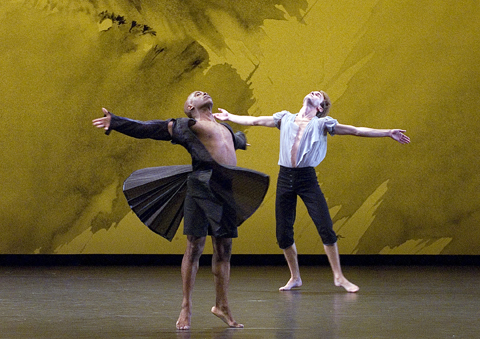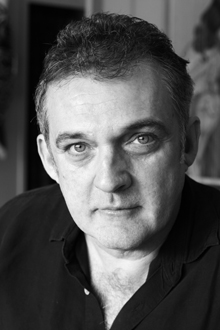
CHOREOMUSICAL A scene from 'Mozart Dances.' [Photo by Gene Schiavone] |
When the Brooklyn-based Mark Morris Dance Group takes the stage at the Vets this Saturday at 8 pm (sponsored by FirstWorks), the audience will get a lot more than just the expressive movement of dance. They will hear the 55-voice Brown University Chorus; they will see visual art by Howard Hodgson; and, yes, they will experience the always-exciting choreography of the founder and artistic director.
Once considered an edgy iconoclast in the world of contemporary dance, Morris is now often mentioned as a successor to George Balanchine. That comparison might be based on Morris’s prolific imagination, his long-lasting repertory, or his instinctual and intellectual intertwining of music and dance.
“I’m far more interested in music than I am in dancing,” Morris admitted, in an interview last week at Brown’s Granoff Center. “Since I dance because of music and always have — whether it was folk dancing or my own choreography — it’s always been about the choreomusical relationship. As a choreographer, I’m a very good musician.”
Indeed, Morris is conducting the Brown Chorus in Bach’s Jesu, Meine Freude, to open the concert — live music to accompany his dancers. That has always been a hallmark of MMDG’s performances, because, as Morris emphasized, “What I always want is music and dancing and audience to all be alive at the same time.”
Morris uses a lot of vocal music, quite a bit of baroque music and, in the last few years, music from the 1920s. He has also set pieces to American roots music (folk, Western swing, Stephen Foster), traditional Balkan music (which he first danced to as a pre-teen in Seattle), and a wide range of classical composers, including Bach, Beethoven, and Mozart, whose Piano Sonata in D Major for Two Pianos provides the score for the second work in MMDG’s Providence performance, aptly titled Double.

"WHAT I ALWAYS WANT is music and dancing and audience to all be alive at the same time," Morris says. [Photo by Amber Star Merkens] |
Double is the middle movement of Morris’s
Mozart Dances, in which the Mozart sonata is flanked by two concerti. But it is the sonata that Morris always considered “the keystone” of
Mozart Dances, and it is also the piece of music that produced the research on the “Mozart effect” — better spatial reasoning while listening.
“It’s very unusual in Mozart’s oeuvre in that it is very surprising and dissonant and pathetic, in the great sense of that word,” Morris noted. “I just couldn’t get away from it — it’s amazing music.”
As for the choral piece, Jesu, Meine Freude, Morris used it for a dance because he wanted “a very profound and deep piece of music.” Its double fugue is mirrored in a choreographic double-fugue, and its complex structure fascinated Morris.
“That’s what drove me to that music,” he insisted. “It’s not about the life of Jesus in any way. I’m a full-on atheist with zero religious interest, but the music is inescapable.”